NSG 6999 (NSG6999)
South University
Page 2 out of 38 results
Sort by
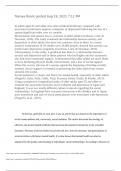
-
Teenya Roark NSG 6999 Study Guides & Final Review Document spring 2023 Complete Solution
- Other • 3 pages • 2023
-
- $8.49
- + learn more
Teenya Roark posted Aug 19, 2021 7:11 PM In adults aged 65 and older, how does medication/therapy compared with increased socialization improve symptoms of depression following the loss of a spouse/significant other over six months. Bereavement and spousal loss is common in older adults (Jacobson, Lord, & Newman, 2016). The study examined the relationship between anxiety and depression in older adults who have lost someone close to them. In a metaanalysis examination of 29 studies over 20,...
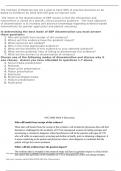
-
NSG 6999 Week 9 Discussion Study Guides & Final Review Document spring 2023 Complete Solution
- Other • 3 pages • 2023
-
- $8.99
- + learn more
The Institute of Medicine has set a goal to have 90% of practice decisions to be based on Evidence by 2020 with the goal to improve care. The intent of the dissemination of EBP results is that the information and intervention is aimed at a specific clinical practice audience. The main objective of dissemination is to increase and advance knowledge regarding evidence-based interventions for greater application and patient outcomes. In determining the best mode of EBP dissemination you must ...

-
Nursing 6999 Week 7 Discussion ALMOST Study Guides & Final Review Document spring 2023 Complete Solution
- Other • 3 pages • 2023
-
- $8.99
- + learn more
Implementation plan PICOT Question Are menopausal women(P) without estrogen replacement (I)more susceptible to UTI(C) menopausal women taking estrogen replacement (O) over a 10-year period (T)? Goals and Objectives The goal and objective are to study menopausal women taking estrogen and does not taking in relation to UTI. Identifying the stakeholders- The stake holders are the patients who volunteer for the study. I will be looking to enroll 100 menopausal patients that are on estrogen t...
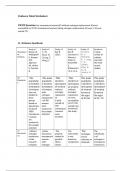
-
Evidence Table Worksheet week 6 nsg 6999 CURRENT Study Guides & Final Review Document spring 2023 Complete Solution
- Other • 10 pages • 2023
-
- $8.49
- + learn more
Evidence Table Worksheet PICOT Question Are menopausal women(P) without estrogen replacement (I)more susceptible to UTI(C) menopausal women taking estrogen replacement (O) over a 10-year period (T)? II. Evidence Synthesis (database) ex: Cochran Study #1 Brown JS, Vittinghoff E, Kanaya AM, Agarwal SK, Hulley S, Foxman B Study #2 Li B, Duan H, Chang Y, Wang S Study #3 Raz R. (2011 Study #4 Raz R, Gennesin Y, Wasser J, Stoler Z, Rosenfeld S, Rottensteri ch E, et al....
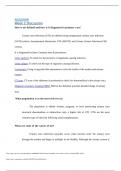
-
NSG 6999 week2Diss Exam study guide.
- Exam (elaborations) • 4 pages • 2023
-
- $8.49
- + learn more
NSG6999 Week 2 Discussion How is uti defined and how is it diagnosed in primary care? Urinary tract infections (UTI) are defined using symptomatic urinary tract Infection (SUTI) criteria, Asymptomatic Bacteremic UTI (ABUTI), and Urinary System Infection (USI) criteria. It is diagnosed by these Common tests & procedures: Urine analysis: To check for the presence of organisms causing infection. Urine culture: To check for the type of organism causing infection. Cystoscopy: Using a long tu...
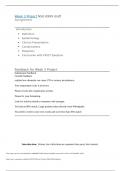
-
Week 3 Project NSG 6999> NSG 6999 complete latest 2023 Exam study guide.
- Other • 7 pages • 2023
-
- $8.49
- + learn more
Assignment Introduction Definition Epidemiology Clinical Presentation Complications Diagnosis Conclusion with PICOT Question Feedback for Week 3 Project Submission Feedback Overall Feedback explain how dementia can cause UTI or urinary incontinence. Your temperature scale is incorrect. Please rewrite the complication section. Please fix your formatting. Look for articles related to treatment with estrogen. You had an 88% match. Large portions taken directl...
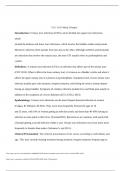
-
NSG 6999 NSG 6999 Week 3 Project Complete Latest 2023Exam study guide.
- Other • 6 pages • 2023
-
- $8.49
- + learn more
NSG 6999 Week 3 Project` Introduction: Urinary tract infections (UTIs) can be divided into upper tract infections, which include the kidneys and lower tract infections, which involve the bladder urethra and prostate Moreover, infection often spreads from one area to the other. Although urethritis and prostatitis are infections that involve the urinary tract, the term UTI usually refers to pyelonephritis and cystitis. Definition: A urinary tract infection (UTI) is an infection that affects...
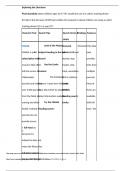
-
NSG 6999 NSG6999_W4_D4.docx EXAMPLE now
- Other • 9 pages • 2023
-
- $8.49
- + learn more
Exploring the Literature Picot Question: In obese children ages 10-17 (P), would the use of a caloric tracking device (I) help in the decrease of BMI percentiles (O) compare to obese children not using a caloric tracking device (C) in a year (T)? Research Tool Search Tips Search Terms & Limits Findings Features CINAHL CINAHL is anSU subscription-only resource that offers full text access to 336scholarly journals and indexes over 3,000 journals from the fields of nursing and allie...
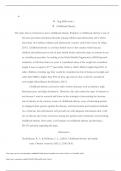
-
NSG 6999 Nsg 6999 week 1 Exam study guide.
- Other • 2 pages • 2023
-
- $7.99
- + learn more
Nsg 6999 week 1 Childhood Obesity The topic that is of interest to me is childhood obesity. Pediatric or childhood obesity is one of the most prevalent nutritional disorder among children and adolescents and it affect more than 14.4 million children and adolescents’ country wide (Van Grouw & Volpe, 2017). Childhood obesity is a serious health issue in the country which has put children and adolescents at risk of poor health which makes the topic an interest to me as a healthcare pro...
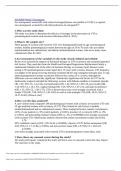
-
NSG 6999 NSG6999 Week 5 Discussion Exam study guide.
- Other • 3 pages • 2023
-
- $7.99
- + learn more
NSG6999 Week 5 Discussion Are menopausal women(P) with reduced estrogen(I)more susceptible to UTI(C) as against non-menopausal women(O) with full production of estrogen(T)? 1.Why was the study done The study was done to determine the efficacy of estrogen in the prevention of UTI in postmenopausal women with recurrent infections (Raz R. 2011). 2.What is the sample size? Three groups of women with recurrent UTI were distinguished based on age: premenopausal women, healthy postmenopausal wo...

That summary you just bought made someone very happy. Also get paid weekly? Sell your study resources on Stuvia! Discover all about earning on Stuvia


